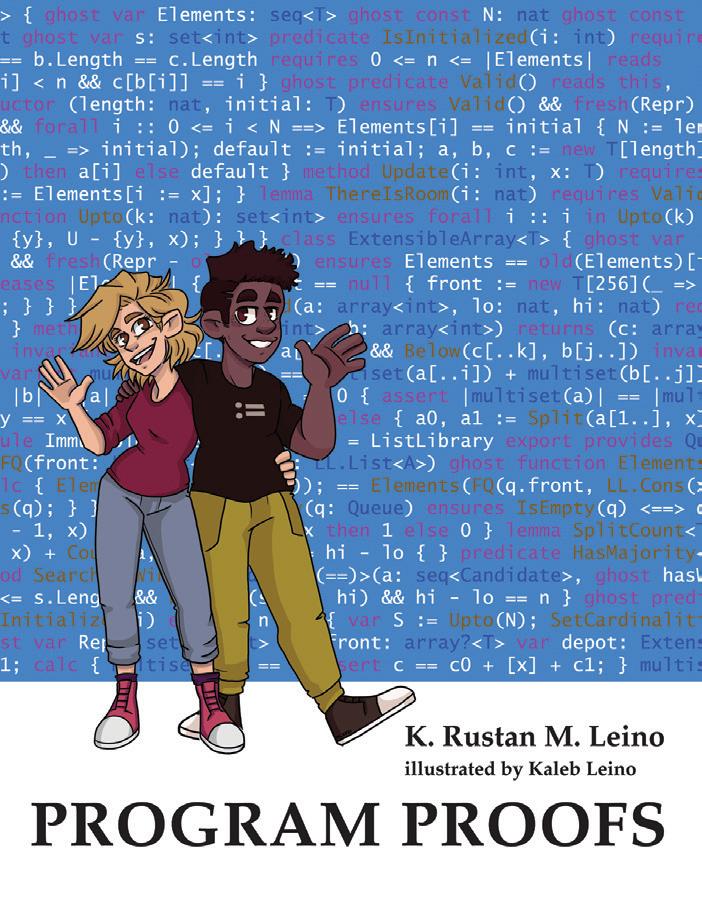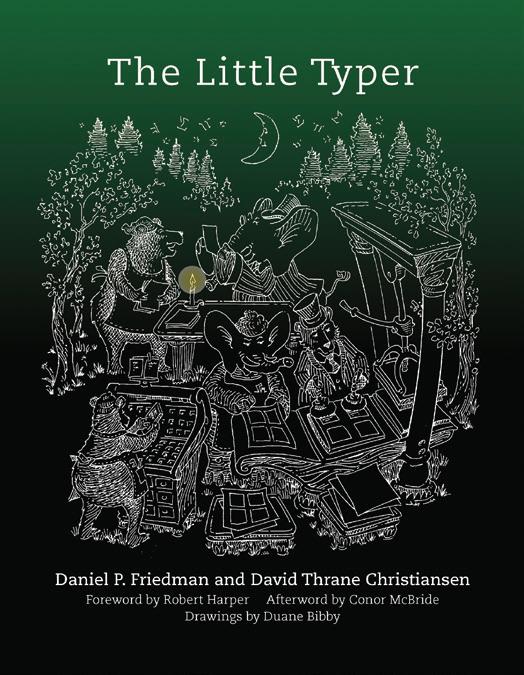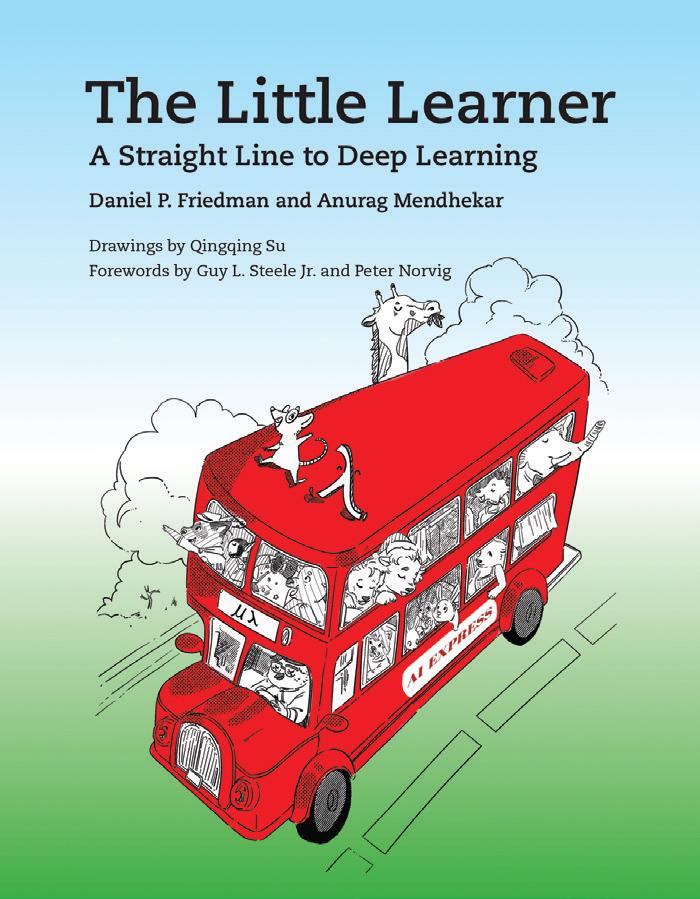
19 minute read
Textbooks
Program Proofs
K. Rustan M. Leino
Advertisement
This comprehensive and highly readable textbook teaches students how to formally reason about computer programs using an incremental approach and the verification-aware programming language Dafny.
Program Proofs shows students what it means to write specifications for programs, what it means for programs to satisfy those specifications, and how to write proofs that connect specifications and programs. Writing with clarity and humor, K. Rustan M. Leino first provides an overview of the basic theory behind reasoning about programs. He then gradually builds up to complex concepts and applications, until students are facing real programs using objects, data structures, and non-trivial recursion. To emphasize the practical nature of program proofs, all material and examples use the verification-aware programming language Dafny, but no previous knowledge of Dafny is assumed.
K. Rustan M. Leino is a Senior Principal Applied Scientist in the Automated Reasoning Group at Amazon Web Services, an ACM Fellow, and a recipient of the CAV Award.
computer science March 7 x 9, 496 pp. 18 line drawings, 4 illus.
US $70.00X/$92.00 CAN paper
978-0-262-54623-2 • Written in a highly readable and student-friendly style
• Builds up to complex concepts incrementally
• Comprehensively covers how to write proofs and how to specify and verify both functional programs and imperative programs
• Uses real program text from a real programming language, not pseudo code
• Features engaging illustrations and hands-on learning exercises
• Detailed and rigorous but accessible approach that guides readers all the way from theory to practical software implementation
• New chapter on GPU ray tracing essential for game developers
• The premier reference for professionals learning about and working in the field
• Won its authors a 2014 Academy
Award for Scientific and Technical
Achievement
• Includes a companion site complete with source code
Physically Based Rendering
From Theory to Implementation
FOURTH EDITION Matthew Pharr, Wenzel Jakob, and Greg Humphreys
A comprehensive update of the leading-edge computer graphics textbook that sets the standard for physically based rendering in the industry and the field, with new material on GPU ray tracing.
Photorealistic computer graphics are ubiquitous in today’s world, widely used in movies and video games as well as product design and architecture. Physically based approaches to rendering, where an accurate modeling of the physics of light scattering is at the heart of image synthesis, offer both visual realism and predictability. Now in a comprehensively updated new edition, this best-selling computer graphics textbook sets the standard for physically based rendering in the industry and the field.
Physically Based Rendering describes both the mathematical theory behind a modern photorealistic rendering system and its practical implementation. A method known as literate programming combines human-readable documentation and source code into a single reference that is specifically designed to aid comprehension. The book’s leading-edge algorithms, software, and ideas—including new material on GPU ray tracing—equip the reader to design and employ a full-featured rendering system capable of creating stunning imagery. This essential text represents the future of real-time graphics.

Matthew Pharr is a Distinguished Research Scientist at NVIDIA. He previously worked at Google, cofounded Neoptica, and cofounded Exluna. Wenzel Jakob is Assistant Professor of Computer Science at the École polytechnique fédérale de Lausanne (EPFL), where he leads the Realistic Graphics Lab. Greg Humphreys is a software engineer at a stealth startup. He previously worked on the Chrome graphics team at Google and as a professor of computer science at the University of Virginia.
computer science March 8 x 10, 1284 pp. 450 color illus.
US $120.00X/$157.00 CAN cloth
978-0-262-04802-6
Bayesian Models of Perception and Action
An Introduction Wei Ji Ma, Konrad Paul Kording, and Daniel Goldreich
An accessible introduction to constructing and interpreting Bayesian models of perceptual decision-making and action.
Many forms of perception and action can be mathematically modeled as probabilistic—or Bayesian—inference, a method used to draw conclusions from uncertain evidence. According to these models, the human mind behaves like a capable data scientist or crime scene investigator when dealing with noisy and ambiguous data. This textbook provides an approachable introduction to constructing and reasoning with probabilistic models of perceptual decision-making and action. Featuring extensive examples and illustrations, Bayesian Models of Perception and Action is the first textbook to teach this widely used computational framework to beginners.
• Introduces Bayesian models of perception and action, which are central to cognitive science and neuroscience
• Beginner-friendly pedagogy includes intuitive examples, daily life illustrations, and gradual progression of complex concepts
• Broad appeal for students across psychology, neuroscience, cognitive science, linguistics, and mathematics
• Written by leaders in the field of computational approaches to mind and brain
Wei Ji Ma is Professor of Neural Science and Psychology at New York University, founder of the Growing up in Science series, and a founding member of the Scientist Action and Advocacy Network. Konrad Paul Kording is Professor of Bioengineering and Neuroscience at the University of Pennsylvania, cofounder of Neuromatch, and codirector of the CIFAR Program in Learning in Machines & Brains. Daniel Goldreich is Associate Professor of Psychology, Neuroscience & Behaviour at McMaster University and director of the undergraduate Honours Neuroscience Program.
cognitive science June | 7 x 10, 360 pp. | 128 color illus.
US $65.00X/$86.00 CAN cloth
978-0-262-04759-3
Essentials of Compilation
An Incremental Approach in Racket Jeremy G. Siek
A hands-on approach to understanding and building compilers.
Compilers are notoriously some of the most difficult programs to teach and understand. Most books about compilers dedicate one chapter to each progressive stage, a structure that hides how language features motivate design choices. By contrast, this innovative textbook provides an incremental approach that allows students to write every single line of code themselves. Essentials of Compilation guides the reader in constructing their own compiler for a small but powerful programming language, adding complex language features as the book progresses. Jeremy Siek explains the essential concepts, algorithms, and data structures that underlie modern compilers and lays the groundwork for future study of advanced topics. Already in wide use by students and professionals alike, this rigorous but accessible book invites readers to learn by doing.
• Deconstructs the challenge of compiler construction into bite-sized pieces
• Enhances learning by connecting language features to compiler design choices
• Develops understanding of how programs are mapped onto computer hardware
• Learn-by-doing approach suitable for students and professionals
• Proven in the classroom
• Extensive ancillary resources include source code and solutions
Jeremy G. Siek is Professor of Computer Science at Indiana University and author of The Boost Graph Library. He invented gradual typing, a type system that integrates both dynamic and static typing in the same programming language.
computer science February | 7 x 10, 240 pp. | 144 illus.
US $50.00X/$66.00 CAN cloth
978-0-262-04776-0
• Conversational style, illustrations, and question-and-answer format make deep learning accessible and fun
• Incremental approach constructs advanced concepts from first principles
• Presents key ideas of machine learning using a small, manageable subset of the
Scheme language
• Suitable for anyone with knowledge of high school math and some
Also available

978-0-262-53643-1

The Little Learner
A Straight Line to Deep Learning Daniel P. Friedman and Anurag Mendhekar illustrated by Qingqing Su Forewords by Guy L. Steele, Jr. and Peter Norvig
A highly accessible, step-by-step introduction to deep learning, written in an engaging question-and-answer style.
The Little Learner introduces deep learning from the bottom up, inviting students to learn by doing. With the characteristic humor and Socratic approach of classroom favorites The Little Schemer and The Little Typer, this kindred text explains the workings of deep neural networks by constructing them incrementally from first principles using little programs that build on one another. Starting from scratch, the reader is led through a complete implementation of a substantial application: a recognizer for noisy Morse code signals. Example-driven and highly accessible, The Little Learner covers all of the concepts necessary to develop an intuitive understanding of the workings of deep neural networks, including tensors, extended operators, gradient descent algorithms, artificial neurons, dense networks, convolutional networks, residual networks, and automatic differentiation.

Daniel P. Friedman is Professor of Computer Science in the School of Informatics, Computing, and Engineering at Indiana University and is the author of many books published by the MIT Press, including The Little Schemer and The Seasoned Schemer (with Matthias Felleisen); The Little Prover (with Carl Eastlund); and The Reasoned Schemer (with William E. Byrd, Oleg Kiselyov, and Jason Hemann). Anurag Mendhekar is Cofounder and President of Paper Culture, where he focuses on developing artificial intelligence for creativity, and an entrepreneur. He started his career at Xerox’s Palo Alto Research Center (PARC), where he was one of the inventors of aspect-oriented programming.
computer science February 7 x 9, 440 pp. 27 illus.
US $55.00X/$73.00 CAN paper
978-0-262-54637-9
Biological Intelligence for Biomimetic Robots
An Introduction to Synthetic Neuroethology Joseph Ayers
From a pioneer in biorobotics, an introduction to how neuroethology can inform the development of robots controlled by synaptic networks instead of algorithms.
The trait most fundamental to the evolution of animals is the capability to adapt to novel circumstances in unpredictable environments. Recent advances in biomimetics have made it feasible to construct robots modeled on such unsupervised autonomous behavior, and animal models provide a library of existence proofs. Filling an important gap in the field, this introductory textbook illuminates how neurobiological principles can inform the development of robots that are controlled by synaptic networks, as opposed to algorithms. Joseph Ayers provides a comprehensive overview of the sensory and motor systems of a variety of model biological systems and shows how their behaviors may be implemented in artificial systems, such as biomimetic robots.
• Introduces the concept of biological intelligence as applied to robots, building a strategy for autonomy based on the neuroethology of simple animal models
• Provides a mechanistic physiological framework for the control of innate behavior
• Illustrates how biomimetic vehicles can be operated in the field persistently and adaptively
• Developed by a pioneer in biorobotics with decades of teaching experience
• Proven in the classroom
• Suitable for professionals and researchers as well as undergraduate and graduate students in cognitive science and computer science
Joseph Ayers is Professor of Marine and Environmental Sciences and Biology in the Marine Science Center at Northeastern University.
technology May | 8 x 10, 448 pp. | 190 color illus.
US $75.00X/$99.00 CAN cloth 978-0-262-04814-9
Computing and Technology Ethics
Engaging through Science Fiction Emanuelle Burton, Judy Goldsmith, Nicholas Mattei, Cory Siler, and Sara-Jo Swiatek
A new approach to teaching computing and technology ethics using science fiction stories.
Should autonomous weapons be legal? Will we be cared for by robots in our old age? Does the efficiency of online banking outweigh the risk of theft? From communication to travel to medical care, computing technologies have transformed our daily lives, for better and for worse. But how do we know when a new development comes at too high a cost? Using science fiction stories as case studies of ethical ambiguity, this engaging textbook offers a comprehensive introduction to ethical theory and its application to contemporary developments in technology and computer science.
Computing and Technology Ethics first introduces the major ethical frameworks: deontology, utilitarianism, virtue ethics, communitarianism, and the modern responses of responsibility ethics, feminist ethics, and capability ethics. It then applies these frameworks to many of the modern issues arising in technology ethics including privacy, computing, and artificial intelligence. A corresponding anthology of science fiction brings these quandaries to life and challenges students to ask ethical questions of themselves and their work.
• Uses science fiction case studies to make ethics education engaging and fun
• Trains students to recognize, evaluate, and respond to ethical problems as they arise
• Features anthology of short stories from internationally acclaimed writers including Ken Liu, Elizabeth Bear, Paolo
Bacigalupi, and T. C. Boyle to animate ethical challenges in computing technology
• Written by an interdisciplinary author team of computer scientists and ethical theorists
• Includes a robust suite of instructor resources, such as pedagogy guides, story frames, and reflection questions
Emanuelle Burton is a Lecturer in the Department of Computer Science at the University of Illinois Chicago, where she teaches courses in ethics. Judy Goldsmith is Professor of Computer Science at the University of Kentucky. Nicholas Mattei is Assistant Professor of Computer Science at Tulane University. Cory Siler is a Graduate Research Assistant in the Narrative Intelligence Lab at the University of Kentucky. Sara-Jo Swiatek earned her PhD in ethics from the University of Chicago.
computer science February | 8 x 9, 504 pp. | 3 illus.
US $85.00X/$112.00 CAN cloth
978-0-262-04806-4
The Developmental Organization of Robot Behavior
Roderic A. Grupen
A comprehensive introduction to the mathematical foundations of movement and actuation that apply equally to animals and machines.
This textbook offers a computational framework for the sensorimotor stage of development as applied to robotics. Much work in developmental robotics is based on ad hoc examples, without a full computational basis. This book’s comprehensive and complete treatment fills the gap, drawing on the principal mechanisms of development in the first year of life to introduce what is essentially an operating system for developing robots. The goal is to apply principles of development to robot systems that not only achieve new levels of performance but also provide evidence for scientific theories of human development.
The book covers motor units, explaining how animals and robots actuate and control their bodies; discusses kinematics and dynamics of articulated sensorimotor mechanisms, including a traditional treatment of the kinematics of grasping; examines the commonly used sensor modalities of vision and touch, comparing them to their biological counterparts; and explores the role of developmental neurology in the first year of life, codifying it in a computational architecture for developmental robotics. Written exercises reinforce the content. Programming projects can be undertaken using a simple robot simulator, “Roger” (named after Paul Churchland’s Roger the Crab). Appendixes provide supporting mathematics, including a primer on linear algebra and integral transforms, common methods for deriving the dynamic equation of motion for articulated systems, the basics of numerical relaxation, and an introduction to Q-learning.
Roderic A. Grupen is Professor of Computer Science and Director of the Laboratory for Perceptual Robotics at the University of Massachusetts Amherst.
computer science March | 7 x 10, 402 pp. | 184 illus.
US $95.00X/$125.00 CAN cloth
978-0-262-07300-4 Intelligent Robotics and Autonomous Agents series
Networks
An Economics Approach Sanjeev Goyal
An accessible and comprehensive overview of the economic theory and the realities of networks written by a pioneering economics researcher.
Networks are everywhere: the infrastructure that brings water into our homes, the social networks made up of our friends and families, the supply chains connecting cities, people, and goods. These interconnections contain economic trade-offs: for example, should an airline operate direct flights between cities or route all its flights through a hub? Viewing networks through an economics lens, this textbook considers the costs and benefits that govern their formation and functioning.
Networks are central to an understanding of the production, consumption, and information that lie at the heart of economic activity. Sanjeev Goyal provides advanced undergraduate and graduate students with an accessible and comprehensive introduction to the economics research on networks of the past twenty-five years. Each chapter introduces a theoretical model illustrated with the help of case studies and formal proofs. After introducing the theoretical concepts, Goyal examines economic networks, including infrastructure, security, market power, and financial networks. He then covers social networks, with chapters on coordinating activity, communication and learning, information networks, epidemics, and impersonal markets. Finally, Goyal locates social and economic networks in a broader context covering networked markets, economic development, trust, and group networks in their relation to markets and the state.
• First textbook to provide a broad and comprehensive overview of twenty-first-century economic theory of networks
• Features engaging case studies and accessible exercises
• Written by a pioneering economics researcher
Sanjeev Goyal is Arthur C. Pigou Professor of Economics at the University of Cambridge, a Fellow of Christ’s College, Cambridge, and Professor of Economics at New York University Abu Dhabi. He is a Fellow of the British Academy, a Fellow of the Econometric Society, and the author of Connections: An Introduction to the Economics of Networks.
economics April | 8 x 9, 816 pp. | 237 color illus.
US $125.00X/$163.00 CAN cloth
978-0-262-04803-3
Regression Modeling for Linguistic Data
Morgan Sonderegger
The first comprehensive textbook on regression modeling for linguistic data offers an incisive conceptual overview along with worked examples that teach practical skills for realistic data analysis.
In the first comprehensive textbook on regression modeling for linguistic data in a frequentist framework, Morgan Sonderegger provides graduate students and researchers with an incisive conceptual overview along with worked examples that teach practical skills for realistic data analysis. The book features extensive treatment of mixed-effects regression models, the most widely used statistical method for analyzing linguistic data.
Sonderegger begins with preliminaries to regression modeling: assumptions, inferential statistics, hypothesis testing, power, and other errors. He then covers regression models for non-clustered data: linear regression, model selection and validation, logistic regression, and applied topics such as contrast coding and nonlinear effects. The last three chapters discuss regression models for clustered data: linear and logistic mixed-effects models as well as model predictions, convergence, and model selection. The book’s focused scope and practical emphasis will equip readers to implement these methods and understand how they are used in current work.
• The only advanced discussion of modeling for linguists
• Uses R throughout, in practical examples using real datasets
• Extensive treatment of mixed-effects regression models
• Contains detailed, clear guidance on reporting models
• Equal emphasis on observational data and data from controlled experiments
• Suitable for graduate students and researchers with computational interests across linguistics and cognitive science
Morgan Sonderegger is Associate Professor of Linguistics at McGill University.
linguistics | science June | 7 x 10, 454 pp. | 6 color illus., 90 b&w illus.
US $60.00X/$79.00 CAN paper
978-0-262-04548-3
Life in Media
A Global Introduction to Media Studies Mark Deuze
A new way to teach media studies that centers students’ lived experiences and diverse perspectives from around the world.
From the intimate to the mundane, most aspects of our lives—how we learn, love, work, and play—take place in media. Taking an expansive, global perspective, this introductory textbook covers what it means to live in, rather than with, media. Mark Deuze focuses on the lived experience—how people who use smartphones, the internet, and television sets make sense of their digital environment— to investigate the broader role of media in society and everyday life.
Life in Media uses relatable examples and case studies from around the world to illustrate the foundational theories, concepts, and methods of media studies. The book is structured around six core themes: how media inform and inspire our daily activities; how we live our lives in the public eye; how we make distinctions between real and fake; how we seek and express love; how we use media to effect change; how we create media and shared narratives; and how we seek to create well-being within media. By deliberately including diverse voices and radically embracing the everyday and mundane aspects of media life, this book innovates ways to teach and talk about media.
• Highlights diverse international voices, images, and cases
• Uses accessible examples from everyday life to contextualize theory
• Offers a comprehensive, student-centered introduction to media studies
• Extensively annotated bibliography offers dynamic sources for further study, including readings and documentary films
Mark Deuze is Professor of Media Studies at the University of Amsterdam’s Faculty of Humanities and coauthor of McQuail’s Media and Mass Communication Theory, among other works.
media studies July | 7 x 9, 312 pp. | 41 color illus.
US $45.00X/$60.00 CAN paper
978-0-262-54558-7
Knowledge Management in Theory and Practice
FOURTH EDITION Kimiz Dalkir
This thoroughly revised fourth edition of the leading knowledge management (KM) textbook offers a comprehensive and accessible overview of the theory and practice of KM.
Today’s knowledge-driven economy raises the stakes for organizations and individuals whose success depends on the effective management of information and knowledge. Knowledge is an asset that is not always easily tapped, especially when embedded in products and in the tacit understanding of highly mobile individual employees. Knowledge management (KM) represents a deliberate and systematic approach to cultivating and sharing an organization’s knowledge base. This thoroughly revised new edition of the leading knowledge management textbook offers a comprehensive and accessible overview of the theory and practice of KM. Drawing on ideas, tools, and techniques from such disciplines as sociology, cognitive science, organizational behavior, and information science, it serves as an invaluable resource for students and researchers across information sciences, business, education, and communication. Global in scope and updated to reflect the maturing field, this fourth edition emphasizes optimizing KM and measuring its success and impact in meaningful ways.
Fourth edition highlights:
• Comprehensively updated to integrate the latest theories, practices, and technologies in KM
• Discusses not only how to implement but how to sustain successful KM strategies and systems in the long term
• Includes new coverage of KM governance and the KM ISO standard introduced in 2018
• Features detailed, real-world vignettes and a wealth of instructor resources, including slides and solutions
Kimiz Dalkir is Associate Professor and Director at McGill University’s School of Information Studies. A practitioner in the field for more than twenty years, she advises companies on the design, development, and evaluation of knowledge-based systems.
business May | 7 x 9, 424 pp. | 79 illus.
US $70.00X/$92.00 CAN cloth
978-0-262-04812-5
Contracts
Happiness and Heartbreak THIRD EDITION Randall Kennedy
A casebook to be used as the primary text for first-year law school contracts courses, written by a leading scholar in contract law.
Renting a home, buying a ticket, downloading an app—humans enter into contracts constantly, often with little consciousness of the legal implications. We typically become alert to the consequences only when a problem arises. Contracting can increase our happiness by enabling us to do things that we would otherwise be unable to do, but heartbreak follows when things go wrong. This casebook, which can be used as a primary text for a first-year law school contracts course, covers a wide spectrum of quandaries that emerge in contract law, from problems of overreach and interpretation to enforcement and fraud. Taken together, these cases offer an exploration of contract pathology and introduce students to concepts that are essential to understanding the vast subject of Anglo-American contract law.
This book is part of the Open Casebook series from Harvard Law School Library and the MIT Press.
• Primary text for a first-year law school contracts course
• Developed for use at Harvard Law School by a leading scholar in contract law
• Diverse cases show differing approaches to a range of problems within contracting
• Classroom tested
Randall Kennedy is Michael R. Klein Professor at Harvard Law School where he teaches courses on contracts, criminal law, and the regulation of race relations.
law April | 7 x 10, 840 pp.
US $85.00X/$112.00 CAN paper
978-0-262-54568-6 The Open Casebook Series








